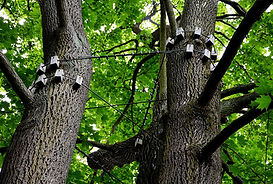
CALL NOW! FOR A FREE ESTIMATE 970-316-1423
Tree Cabling & Bracing
When trees are not properly pruned or trained when young, they can grow in ways that threaten their health and the safety of the people and buildings around them. Mature trees with two or more trunks are particularly susceptible to this condition. So, too, are open-canopied trees with limbs that grow horizontally or downward. Newly-planted trees can sometimes be weak-trunked or unstable, caused by close planting in the nursery, inadequate root balls, root damage, or planting in too-shallow holes or compacted soils.
Tree Cabling & Bracing can be appropriate remedies for trees with structural deficiencies and instability. When installed and maintained correctly, these support systems can:
1. Reduce the likelihood of failure of a weak or previously damaged trunk or limb, or a tree with
co-dominant leaders, especially during severe weather.
2. Extend the life of an old tree.
3. Provide added stability to newly-transplanted trees while they build supportive root systems.
1F Services will inspect your trees to diagnose any structural deficiencies that pose potential risk to other trees and the surrounding property. We will then advise you if a supplemental support system is appropriate to remedy a structural problem, and if so, recommend the best type of system for the tree. These mechanisms support the tree by limiting the movement of branches or leaders and/or providing extra support to weak areas of the tree. However, this support hardware is also intrusive and restrictive for the tree.
Cabling reduces the risk of breaking or splitting by restricting the distance branches or co-dominant leaders can move in relation to the rest of the tree. The cables are typically installed in the upper crown or across a weak crotch (the bottom point of connection between two or more tree limbs or trunks).
Bracing rods are installed in trees with multiple or co-dominant leaders to reduce the risk of the leaders splitting or to repair splits that have already occurred. The rigid braces are installed directly through the union of the weak branches and stems — either as a “through-rod” or a “dead-end” brace. Bracing rods are combined with cabling to gain the most stable support.
It is important to note that most of the structural defects that require the installation of supplemental support systems could have been prevented through proper pruning and maintenance throughout the tree’s life. If you get a 1F Services to care for your tree every two years after it’s been planted, it will likely never develop structural defects!


Get a Free Cabling & Bracing Estimate
Contact us today and we'll come by to give you a free estimate.
